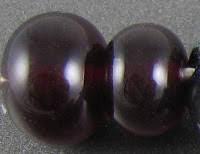CiM Wheatgrass (CiM471) is a medium, misty opal green. It reminds me of Effetre Dark Emerald, but the wispiness gives it more depth.
Wheatgrass doesn't change colour when you reduce it.
Silver is pretty on Wheatgrass. It dispersed all over the surface of the leftmost bead and left a bluish haze all over the surface. In the rightmost bead, you can see I got lots of blue fumey 'glow' from the silver on top of Wheatgrass. In the centre bead, I encased silver foil with Wheatgrass on top of Wheatgrass and you can see that the silver stays true under Wheatgrass, resulting in a reflective green.
Silver Glass is also quite nice on top of Wheatgrass. I got pretty colours from my reduction frit, and a gorgeous red/purple starting strike from my TerraNova2 frit.
On top of Wheatgrass, Copper Green, Opal Yellow, Ivory, and Peace all separate.
When the Wheatgrass is on top, this reaction is only evident in the Copper Green.
Here are some other beads made with Wheatgrass.























